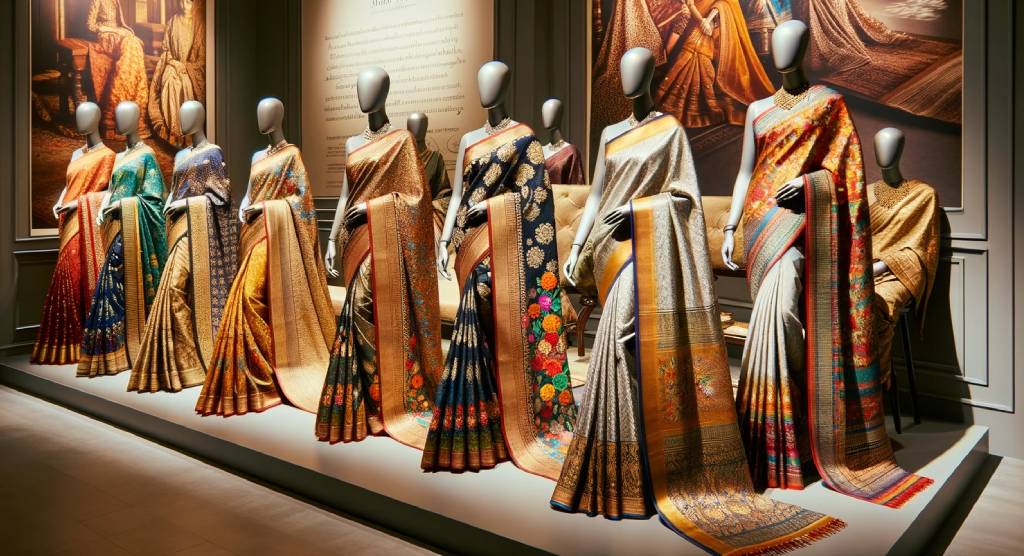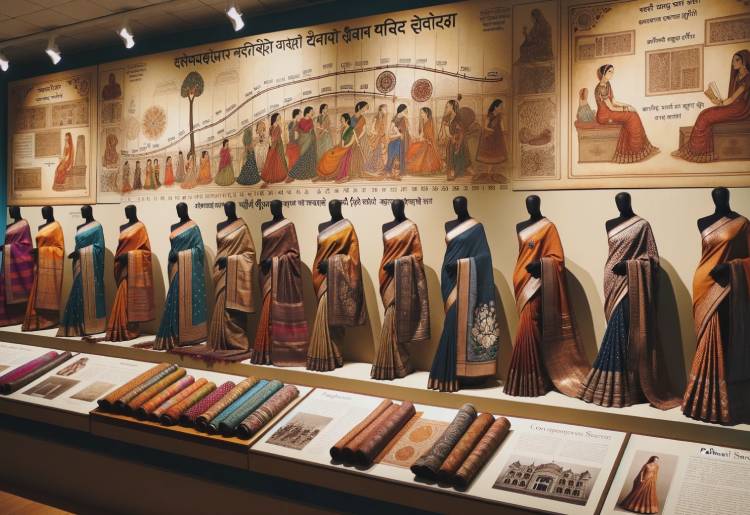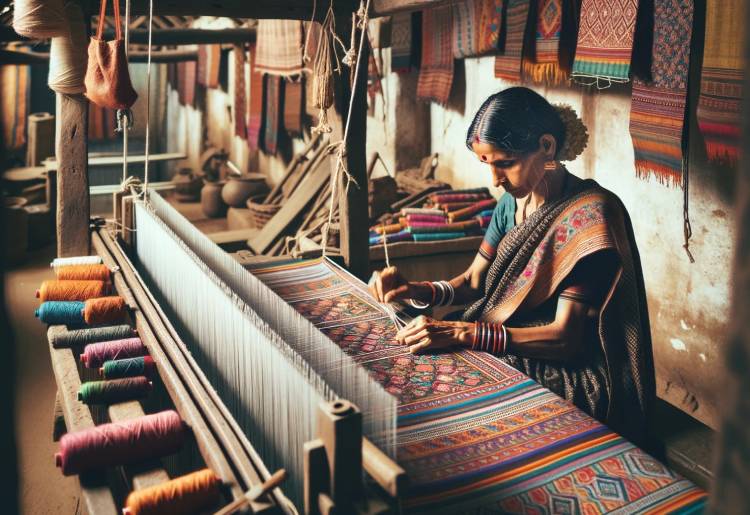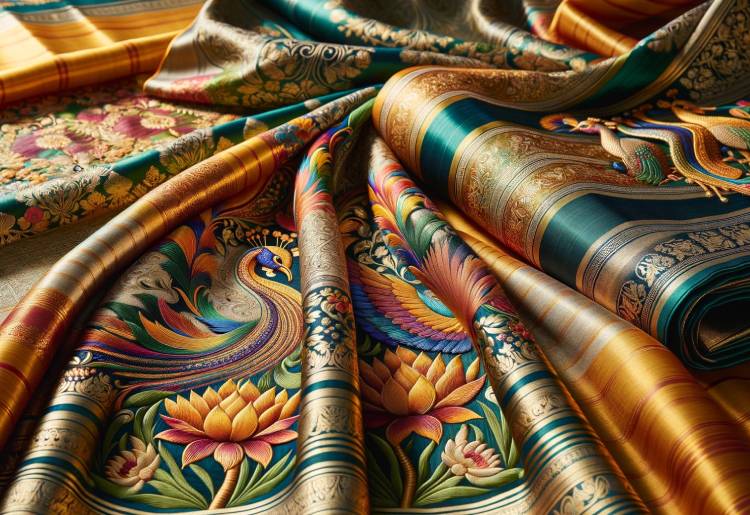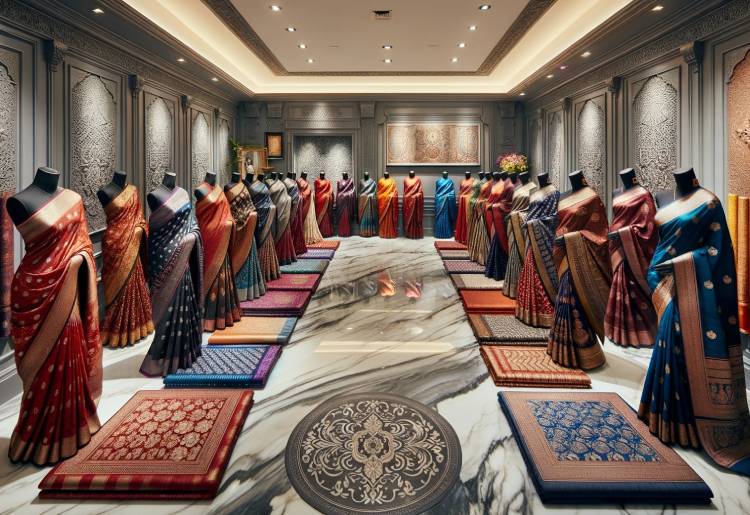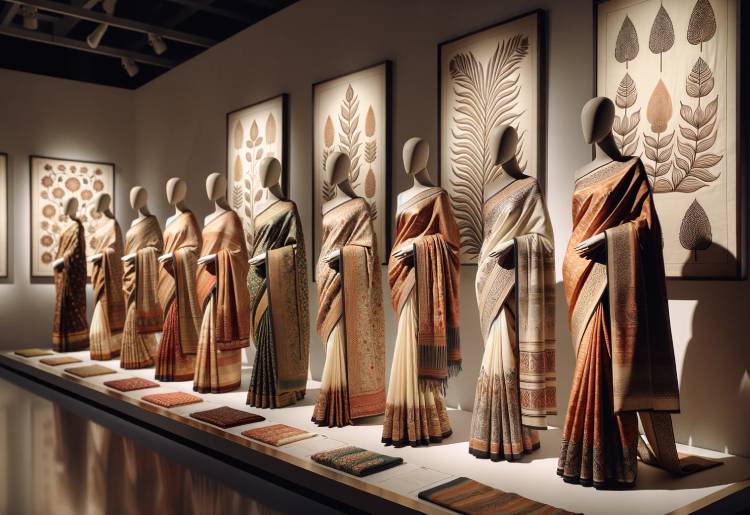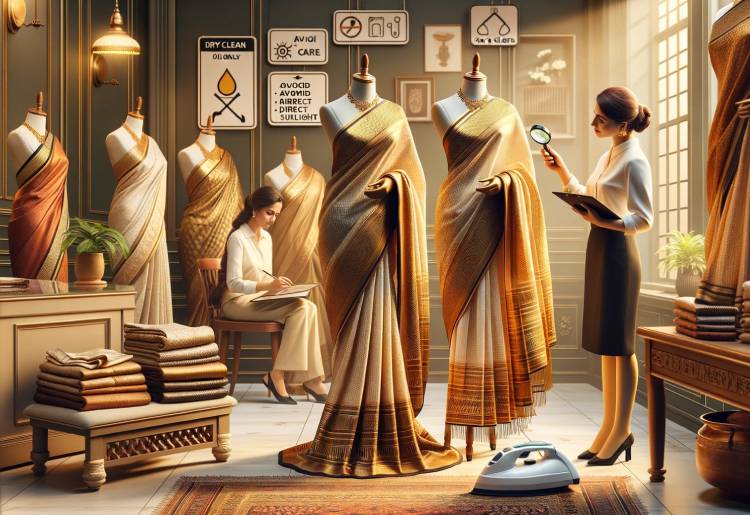The Paithani Saree, a stunning traditional garment from Maharashtra, is a masterpiece that adorns women on special occasions. It is crafted with luxurious silk and intricate handwoven motifs, embodying the rich cultural heritage of the Deccan region.
This saree dates back to the imperial era of the Satavahanas, who ruled around 230 BC. Initially, it was solely meant for royalty and nobles symbolizing wealth and prestige. But, over time it became popular among common people too.
The weaving technique called ‘tapestry’, is what sets Paithani Sarees apart. Vibrant and colorful designs are created by interlacing colorful threads into the fabric with skill and precision. It requires immense craftsmanship and patience to create the intricate patterns, making each Paithani Saree a true work of art.
Real gold and silver threads are used in their creation, adding opulence and grandeur to these sarees. This is why they are highly sought after by fashion enthusiasts and collectors.
Pro Tip: To maintain the beauty and longevity of your Paithani Saree, always dry clean it. Avoid using harsh detergents or bleach which may damage the fabric or fade its vibrant hues.
History of Paithani saree
The Paithani saree – a timeless masterpiece of Indian weaving – holds a rich and captivating history. Believed to have begun in the town of Paithan, Maharashtra, India, each saree tells a story spanning centuries.
Vibrant colors, intricate motifs, and nature-inspired designs are all part of the unique weaving technique. It involves interlocking different colored threads to create elaborate patterns that come alive on the fabric.
These luxurious garments were historically worn by queens and noblewomen. During the reign of the Maratha empire, they gained immense popularity, becoming an essential part of Maharashtrian culture.
Skilled artisans pour their heart and soul into every creation. Using traditional methods passed down through generations, these weavers meticulously handcrafted each piece.
Narkpurne Lalaji Balajirao Heggadkar Shahi from Samarth Families in Yeola is one such remarkable story. He is considered one of the finest weavers in recent times. He revived rare Paithani designs that were on the brink of extinction. His passion for this age-old art form has ensured its continuity.
As we admire the beauty and intricacy of a Paithani saree, we remember the countless hours of labor and dedication that have gone into creating it. This magnificent piece of art embodies grace and cultural richness – a legacy that will continue to flow with time.
The making of Paithani saree
To understand the intricate process of creating a Paithani saree, dive into the making of this exquisite traditional garment. Explore the materials used and the weaving process, unraveling the artistry behind this iconic attire. Discover the secret behind its ethereal beauty and painstaking craftsmanship.
Materials used
Paithani sarees are renowned for their beauty and class. They are crafted with a unique mix of materials that make them timeless. Silk, gold and silver threads, natural dyes and cotton yarn – all these elements are important for defining the quality and look of Paithani sarees.
Silk threads are the foundation. They are carefully chosen for their texture and durability. Gold and silver zari threads are woven in for extra opulence and grandeur. Natural dyes, like turmeric, indigo and pomegranate skin, give the sarees their colours. These dyes are safe for the skin.
Cotton yarn is used to create the intricate patterns and motifs. The silk and zari threads are then delicately embroidered onto this base. Cotton yarn adds comfort to the saree.
Each material used in the making of Paithani sarees has a purpose. Together, they tell a story of tradition, craftsmanship and beauty.
Experience the luxury of silk against your skin. Adorn yourself with the shimmer of gold and silver. Own a piece of history. Make a fashion statement with a Paithani saree. Embrace the elegance of Indian tradition.
Weaving process
Weaving Paithani sarees is a mesmerizing experience. Every step in creating this exquisite fabric is a story of dedication and artistry.
Silk threads are carefully selected to form the base of the saree. Then they are dyed with vibrant natural colors. Pit looms, passed down through generations, are set up for weaving.
Using their nimble fingers, the weavers intricately interlace each thread to form complex motifs and patterns. This requires immense precision and attention to detail. The intricate weave reveals the beauty and richness of the saree.
Gold and silver zari threads add opulence and grandeur to the fabric. When the shimmering elements catch the light, it is a sight to behold.
Ramchandra Dattatraya Mugutkar dedicated his life to perfecting Paithani weaving. He has preserved this ancient craft for future generations.
The process behind Paithani sarees is more than just creating a garment. It symbolizes human creativity and perseverance. Each saree embodies centuries-old traditions. It is no wonder they hold a special place in every woman’s wardrobe, symbolizing both tradition and timeless elegance.
Characteristics and design of Paithani saree
To understand the characteristics and design of Paithani saree, delve into its vibrant color combinations, intricate patterns, and captivating motifs. Explore the artistry behind each element, from the mesmerizing interplay of hues to the rich storytelling woven within the fabric. Discover how these aspects contribute to the timeless allure of the Paithani saree.
Color combinations
Paithani sarees boast a vast range of color combinations; from bold and contrasting to subtle and harmonious. Contrasting combos like deep red and gold, and black and silver create an eye-catching effect. Harmonious colors, like pastel shades, bring grace.
The special touch? Real gold and silver threads woven with silk, adding a luxurious feel. This interplay between shimmering metal and vibrant silk creates a unique effect.
The color palette is inspired by nature; peacock blue, marigold yellow, ruby red, emerald green, and more. These colors not only capture nature’s beauty, but also hold cultural symbolism.
Fashion designer Ritu Kumar says, “Paithani sarees are known for their elaborate motifs and intricate weave patterns. Colors blend together to create skilled craftsmanship.”
Patterns and motifs
The peacock motif of Paithani sarees is a popular symbol of beauty and grace. Floral designs like lotus, rose, and jasmine are used to represent purity and femininity. Geometric patterns such as squares, circles, and diamonds add a contemporary touch. Vibrant colors like deep red, royal blue, and golden yellow are characteristic of these sarees. Zari work with gold or silver threads enhances the richness and grandeur. Borders feature intricate motifs inspired by nature or ancient architectural elements.
Each pattern and motif holds a deeper meaning in Indian culture. For example, the fish motif stands for fertility and prosperity while the mango motif means abundance and good fortune. These symbolic representations make Paithani sarees not just fashionable but also carriers of cultural significance.
The legend of Parvati’s Blessing is an interesting story. Parvati was a weaver who could only produce half a saree a day. She prayed for help and, miraculously, she found an entire half-saree completed with an exquisite pattern that matched her weaving style. This unique design has become a source of inspiration for weavers and saree enthusiasts.
The patterns and motifs of Paithani sarees demonstrate the skill and creativity of the artisans. These timeless designs are passed down through generations, preserving the tradition and adorning women with elegance.
Significance of Paithani saree in Indian culture
To understand the significance of Paithani saree in Indian culture, delve into its traditional occasions and festivals, and explore its historical importance.
Traditional occasions and festivals
At traditional events and festivals, the Paithani saree is a symbol of elegance and tradition. It’s adorned with intricate designs and vibrant colors, showcasing Indian craftsmanship. This saree is often passed down through generations, carrying stories of love, prosperity, and cultural pride.
What sets the Paithani saree apart is its ability to make the wearer a “walking piece of art.” The silk fabric drapes gracefully over the body, accentuating grace and poise. The saree’s hues add vibrancy to the occasion.
The sarees uniqueness lies in its versatility. It can be styled in various ways, letting the wearer express their personality while still honoring tradition. Whether worn for weddings, religious ceremonies, or other festive gatherings, this timeless garment will stand out.
Historical importance
The Paithani saree is a symbol of tradition and elegance in Indian culture. It originated in the 2nd century BC ancient city of Paithan in Maharashtra, India. It has intricate and colorful designs inspired by nature, folklore, and religious motifs. It takes skilled artisans several months to weave one. The silk comes from Karnataka and Andhra Pradesh. It has real gold and silver threads. The pallu has peacock designs – symbolizing beauty and grace. It is reversible so women can wear it either side.
A fascinating story about Paithani sarees involves Great Maratha King Shivaji Maharaj. He gifted a special Paithani saree to his mother Jijabai after a victorious battle. This showed his appreciation for her and the value placed on these garments in ancient times.
Famous Paithani saree patterns and motifs
To explore famous Paithani saree patterns and motifs, dive into the vibrant world of these exquisite garments. Discover the allure of the Peacock motif, the elegance of the Lotus motif, and the richness of the Mango motif. Each is a unique expression of artistry, weaving history, culture, and beauty into every thread.
Peacock motif
The peacock motif in Paithani sarees is regal. Each detail is woven into the fabric, capturing the feathers’ essence. It displays a captivating and enchanting array of colors.
The motif is symbolic too. Peacocks are symbols of love and fidelity in Indian culture. They represent prosperity, luck, and divine protection. The saree’s detailing reflects these deeper meanings.
Legend says a queen was mesmerized by a peacock dancing in her palace garden. She commissioned weavers to make sarees adorned with intricate peacock motifs. These sarees were sought-after among royalty and nobility.
The peacock motif is still integral in Paithani saree designs. It transcends boundaries, captivating people across generations. So, when you admire a Paithani saree with a peacock motif, remember its rich history and symbolism. It makes it special.
Lotus motif
The lotus motif in Paithani sarees is a symbol of purity, elegance and spiritual enlightenment. It’s a beloved choice among women for its intricate design and symbolic meaning. The lotus is often depicted with bright colors, depicting its varied stages of bloom – from bud to full blossom. This motif adds grace and sophistication to the saree, making it a timeless piece of art.
The lotus holds great significance in Indian culture. For centuries, it has been used to represent purity and divinity. In Hindu mythology, it stands for beauty, wealth, knowledge and spirituality. The detailed petals and delicate curves of the stem make the lotus motif mesmerizing in Paithani sarees.
Paithani sarees are renowned for their heritage. They were traditionally woven by skilled artisans using pure silk threads. The lotus motif has been an important part of Paithani saree designs for generations. It has changed over time, with various forms such as single-petal or multi-petal lotuses. Each with its own allure.
Legend has it that the inspiration for the lotus motif in Paithani sarees came from Raja Bhoja and his queen Bhagirathi. As they were walking through their palace garden one evening, they saw a beautiful lotus blooming under the moonlight. Mesmerized, they decided to put its beauty into their royal attire. Thus, the lotus became a prominent motif in Paithani sarees.
Mango motif
The mango motif is an iconic part of Paithani sarees. It symbolizes fertility and prosperity. The artisans weave these mango-shaped motifs in vivid colors, giving them an elegant look.
The mango motif stands for abundance and good luck. Its curved shape is often adorned with gold or silver thread work.
Its versatility is remarkable. It can be woven in a huge range of sizes and styles. Some sarees have big mango motifs spread across the fabric, others have smaller motifs in repeating patterns.
The creators of these sarees must undergo long training. It takes weeks, even months, to craft a Paithani saree due to its intricate detailing.
Interestingly, it is said that Paithani sarees date back to 200 BC, during the Satavahana dynasty. This adds to our understanding of this ancient art form.
Buying and caring for a Paithani saree
To ensure that you make the most informed decisions while buying and caring for a Paithani saree, we present you with essential tips. Discover how to identify and purchase an authentic Paithani saree, as well as learn the proper storage and maintenance techniques required to preserve its beauty.
Tips for purchasing an authentic Paithani saree
Buying an original Paithani saree can be tough. Here are some tips to make the right choice. Firstly, find a reliable shop that specializes in Indian fabrics. Secondly, see the silk used; pure silk has a special shine and feel. Also, check the embroidery of the zari work as high-quality Paithani sarees have fine gold or silver thread.
Unique facts about Paithani sarees? They have vibrant colors and nature-inspired designs. Each saree is woven by hand by artisans, so everyone is unique. The blend of silk cloth and zari work makes them look luxurious.
My Paithani saree story? I was in India and found a shop in Maharashtra. They sold Paithani sarees and explained their history and importance. I was impressed with the craftsmanship and detail. I chose a red and gold saree that I treasure.
Proper storage and maintenance
Store your Paithani saree in a clean, dry place away from direct sunlight. Avoid folding or creasing the saree. Inspect it regularly for any signs of damage. If there are stains, dab them with a mild detergent.
Paithani sarees are artworks woven by artisans. They have intricate motifs and vibrant colors that make them cherished possessions. So, it’s important to adhere to proper storage and maintenance practices. Else, there could be irreversible damage or loss.
Preserve your Paithani saree today. Enjoy its beauty and cultural significance for years to come. Pass down this legacy and share its stories with generations ahead.
Modern adaptations and innovations in Paithani sarees
To explore modern adaptations and innovations in Paithani sarees with contemporary designs, fusion with other fabrics and styles is the solution.
Contemporary designs
To give Paithani sarees a modern twist, designers have re-imagined motifs, combined colors, and experimented with textures. Borders are now being crafted with intricate geometrics and abstract designs. Plus, they can be draped in unconventional ways. To add an extra sparkle, embellishments such as sequins and beads are used.
To make the most of these innovations, a few tips can be followed:
- Balance a minimalistic contemporary Paithani saree with statement accessories.
- Experiment with different draping styles to personalize the look.
- Opt for customized designs for exclusivity.
By using these suggestions, one can showcase the rich heritage of Paithani sarees in an up-to-date fashion.
Fusion with other fabrics and styles
Paithani sarees have evolved – fusing with other fabrics and styles to create unique creations. Mixing silk and cotton adds to their beauty.
Designers are mixing different textiles, from georgette to chiffon to velvet, to create contemporary versions of the classic sarees. This blend of fabrics modernizes the traditional garment, while maintaining its essence.
Moreover, the fusion goes beyond fabrics. Design elements and patterns from other cultures also contribute to the innovation of Paithani sarees. Embroidery work, modern motifs, and unusual colors are some examples of how these sarees have been adapted.
This fusion is not new. Historical evidence suggests that Paithani sarees were influenced by Persian art forms during the Mughal era. The intricate weaving techniques used in Persian shawls were used to create Paithani sarees, resulting in beautiful amalgamations of two distinct textile traditions.
Final thoughts on Paithani Saree
Paithani saree – a traditional Indian garment – is renowned for its craftsmanship and history. Its intricate designs and vivid colors make it an eternal piece of art. Handwoven with fine silk threads, the fabric flows gracefully.
This cultural masterpiece has deep roots in Maharashtra. Skilled artisans create each saree by hand, weaving multiple colored threads to form complex motifs and patterns. A unique aspect of Paithani sarees is their reversibility – both sides of the fabric are beautiful. This allows for different designs depending on your preference or occasion.
Real gold and silver threads are used in certain Paithani sarees, adding more grandeur to the garment. Ideal for festive occasions and weddings! Care instructions should be followed to maintain the beauty of your Paithani saree. Dry cleaning is recommended.
Complete the look – pair your Paithani saree with antique jewelry or traditional accessories. Embrace the cultural heritage associated with this magnificent garment.
Q: What is a Paithani saree?
A: A Paithani saree is a traditional handwoven saree originating from the state of Maharashtra, India. It is known for its exquisite silk fabric, vibrant colors, and intricate zari work.
Q: How are Paithani sarees made?
A: Paithani sarees are made using a technique called “tapestry weaving.” Skilled artisans weave the saree on a handloom using pure silk threads. The zari work is done separately and then added to the fabric, enhancing its beauty.
Q: What makes Paithani sarees unique?
A: Paithani sarees are unique due to their rich history and cultural significance. They feature intricate motifs inspired by nature, such as peacocks and lotus flowers. The use of pure silk and gold zari adds a touch of luxury to these traditional sarees.
Q: How do I care for a Paithani saree?
A: To care for a Paithani saree, it is recommended to dry clean it to maintain its color and fabric quality. Avoid exposing it to direct sunlight for long durations and store it in a muslin cloth to ensure its longevity.
Q: Can I wear a Paithani saree for special occasions?
A: Yes, Paithani sarees are widely worn for special occasions like weddings, festivals, and traditional ceremonies. They are considered a symbol of elegance and grace and can make a beautiful choice for such events.
Q: Where can I buy authentic Paithani sarees?
A: Authentic Paithani sarees can be purchased from reputed saree showrooms, government emporiums, or online platforms that specialize in traditional Indian weaves. Ensure that the seller provides proper documentation of authenticity.


